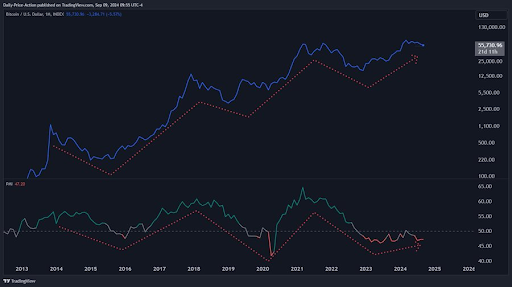Renowned analyst Justin Bennett has provided insights into why the Bitcoin four-year cycle may have come to an end for the time being. He suggested that the anticipated price increase for Bitcoin within this market cycle may not materialize as expected, potentially leading to a significant price drop in the near future.
Reasons The Bitcoin Four-Year Cycle Could Be Concluding
In a post on X (formerly Twitter), Bennett stated that Bitcoin behaves in alignment with business cycles, providing insights into why the leading cryptocurrency might be entering a new phase. He pointed out that Bitcoin has consistently adhered to four-year cycles since its launch, experiencing two-year periods of both bear and bull markets.
Nevertheless, Bennett proposed that this trend could be changing, as Bitcoin’s link to business cycles suggests that a downturn might end its traditional four-year cycles. To illustrate Bitcoin’s alignment with these cycles, he referenced how Bitcoin has historically mirrored the US Purchasing Managers’ Index (PMI) from the beginning.

This index assesses economic health based on activity in the manufacturing and service sectors. The accompanying chart indicates that BTC’s price has increased whenever the PMI rises and decreases when the index falls. In this context, Bennett asserted that this correlation will persist during any forthcoming short-term or long-term downturn.
Interestingly, such a contraction may already be on the horizon, suggesting that Bitcoin’s four-year cycle could be ending. The US PMI is currently at a value of 47.20, indicating a contraction. This state occurs when a nation’s economy is in decline, which is applicable to the US presently as the Federal Reserve struggles to reduce inflation while evading a recession.
Moreover, it’s important to note that the current US economic landscape has significantly influenced Bitcoin’s lackluster price movement since it achieved a new all-time high (ATH) in March. Investors in Bitcoin have remained vigilant as the US inflation statistics and job reports reveal the fragility of the US economy.
Implications for BTC’s Price
Bennett remarked that Bitcoin’s relationship with business cycles does not preclude its price from rising. However, he cautioned that it is crucial to recognize that BTC is a risk asset influenced by the economic climate post-2008. He emphasized that it is not “programmed to go up” as some crypto analysts have anticipated, nor is it bound to follow a “rainbow chart” or a stock-to-flow model.”
The analyst’s views have certainly raised skepticism regarding optimistic forecasts tied to halving cycles. Historically, Bitcoin tends to reach new peaks 16 to 18 months following a halving event. Yet, with Bennett hinting that this ideal cycle may have concluded, this pattern may not hold true this time around. Indeed, this cycle has already demonstrated differences, considering that the leading cryptocurrency attained a new ATH before the halving, a scenario that has never occurred before.
As of this writing, Bitcoin is priced at approximately $57,900, having slid nearly 1% in the last 24 hours, according to data from CoinMarketCap.
Featured image created with Dall.E, chart from Tradingview.com








